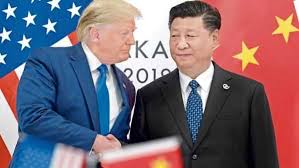 India is the largest emerging market economy in the world and has the potential to grow substantially from here on. India’s fastest growing services sector which contributes almost 55% in the Indian economy. There are various other sectors where India can fill the space vacated by China.
India is the largest emerging market economy in the world and has the potential to grow substantially from here on. India’s fastest growing services sector which contributes almost 55% in the Indian economy. There are various other sectors where India can fill the space vacated by China.This ongoing tensions between the USA and China have brought about a lot of opportunities for India. The inflection point of this trade stand-off begun with the humungous amount of trade deficit between the USA and China which prompted the action by President Trump when he first started imposing massive tariffs on Chinese goods to reduce the trade deficit.
Now we are embarking on a new journey where we must begin to think about trade in an entirely different way and grab the opportunity in this fiercely competitive world. The advent of technology poses more challenges to traditional approaches of working where India has to position itself for more prosperity.
Multinational companies currently operating in China now started thinking to move its operations out of China to diversify and reduce the risk emerging out of the USA which poses significant headwinds not just to China but to the global economy as a whole.
Several economists through-out the globe have written about the possibility of benefitting from the Foreign Direct Investment (FDI ) and provide a conducive environment for the global investors so that they start committing vast sums of money that result in large-scale job creation which India desperately needs for its rising young generation.
To support this line of argument, the government’s own data suggests that labor force participation(LFP), which is an economic indicator that indirectly tells the story of unemployment or severe underemployment in India.
On the export front, India can contribute a lot more and establish itself as a power-house of exports and increase its share as a percentage of GDP. Due to the disruptions of the global supply chains, it can be part of those supply chains to improve its way to prosperity.
China’s merchandise exports are equal to the size of the Indian economy. The need of the hour is to build a strong strategy on the export front because a 10% shift of Chinese exports to India will sharply increase its share of exports as a percentage of gross domestic product (GDP).
Today multinational companies are ready to invest and expand its business operation in India primarily because of political stability and sustained improvement over the last few years that captures the imagination of the investors.
India is the largest market in the world and a lot of potentials still untapped that’s the main reason MNC’s find it interesting to penetrate deep into the Indian markets and gain as much as the profit they can besides opening a lot of horizons along the way.
The government of India’s initiative of making in India can give a colossal fillip to the Indian economy provided few structural reforms that will provide confidence not just to domestic investors but to global investors. India needs to improve its policy execution of support policies like the startup India, make in India, smart city program. All these policies will lead India to a new level.
Create an export hub – One engine on which China multiplied and increased its way to prosperity and today has taken center stage and prove its capability to take on China. It’s crucial for India to increase its exports substantially that’s the only way to compete with other emerging market peers.
To give specific focus, certain selected sectors significant for employment, technology, and exports should be identified for launching the program. These ‘champion’ sectors could be textiles and apparel, automotive products and electronics (with emphasis on mobiles), to be supplemented with a few other industries later. These three sectors in India are likely to contribute over $1 trillion by 2025.
India should identify about five key companies – lead firms – in each sector and open direct negotiations with them to facilitate either shifting or adding new capacity in the country to boost exports. These policies which would pave the way for export hubs in India, need to be administered by relevant government agencies, and, thus, should be framed and managed in a coordinated and facilitative manner.
The principal conclusion of this article is how India can navigate through this uncertain and fragile environment and position itself as a prime challenger, particularly in the economy.




